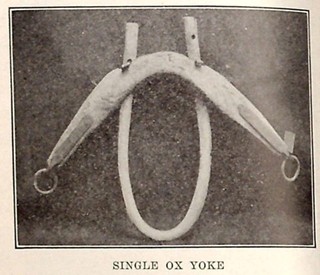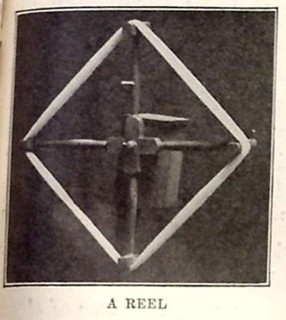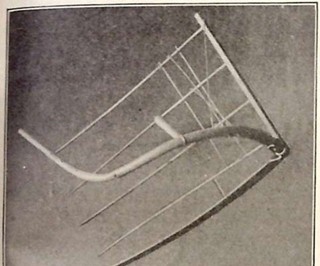This was cut and carefully dried in the warm days of summer. The new mown hay was stacked near the hay-covered stable and when fierce storms blew across the prairies it was carried to the stock safely sheltered within. The fragrant dried grass, when kept well, was sufficient to keep horses and cattle through the long winter. Sometimes one reads about the fragrance of the new mown hay; but it does not mean very much unless one has really smelled it in the field or mow when it was being made in the summer time.
The farmer swung his scythe close to the ground in a wide circle, and laid the long grass at his left side in a smooth windrow. Men and women or boys and girls came behind and with a wooden rake spread the grass out thinly over the short, sharp stubble. The hot sun dried it and, when cured, it was quickly raked together and gathered under cover or in stacks which would shed the rain. If, when the hay was ready to bring in, a rain should suddenly come up, there was a great hurrying of the work by all hands. For if the dry hay should be wet its fragrance would be largely spoiled.
The modest way of harvesting and haying by such simple machinery was soon changed. Horse machines were used to mow hay and to cut the grain. A mower was invented and the sharp sickle running rapidly back and forth on a long bar caused the grass to fall in a small swath behind it. The hay could then dry without being spread by hand; and it could be raked into windrows by hand rakes or by a horse-rake, which was likewise soon invented. A wooden horse-rake was not hard to make and, as he made other useful apparatus, the farmer put together his own or bought a patent one.
The first reaper for grain had a platform which caught the falling stalks. A man came along behind or rode on the machine and when a bundle was big enough, he pushed it off on the ground. Other men and boys, four or five perhaps, followed and bound up the sheaves with a straw band. A single machine at first was made use of by a good many families in the same neighborhood, because they could help each other in binding up the sheaves and gathering them into shocks. By and by when all the grain was cut by machines and stacked in one place, and when machines to thresh the sheaves had been invented, the neighbors would help each other thresh the whole harvest at once. No one refused to help unless he had some misfortune which would excuse him.
To find a market for the crops was one of the most important things for the first settlers. There was no way to get wheat or meat to the towns on the Mississippi where boats could carry the produce away, except by teams. And the bad sloughs, which heavy loads would scarcely cross, made teaming very hard. Only by going together with several loads and by helping each other could men reach the market.
For a short time there was great hope that boats would run regularly on the Wapsipinicon, on the Cedar, on the Iowa, and on the Des Moines Rivers. These rivers could be used then to carry away the farmers’ crops. The boats did run and in some cases on the Cedar as far up as Waterloo, on the Iowa as far as Iowa City, and on the Des Moines far up into the State. A good sized boat ran clear from Pittsburg, Pennsylvania to Cedar Rapids. Down the Ohio and up the Mississippi and the Cedar Rivers it journeyed without any mishap; and when such a trip could be made, people believed that Iowa rivers would be navigable.
Cargoes of flour were taken down the Cedar River to the markets at St. Louis. Passengers were carried down the Iowa river on several occasions, and once a cargo of corn which was being towed down stream on a flat boat was lost in the river because the flat boat broke into two pieces. But the hope that this trade would continue was soon given up and attention was turned to getting a railroad.
A good many years went by before the things needed in the new home were made in factories. And some persons have believed that it was a happy time in the history of the United States, and of our State, when almost everything one needed was made at home. All persons seemed contented, unselfish, and glad to help an unfortunate neighbor.






